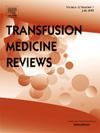The Association Between Anemia and Bleeding in Thrombocytopenic Patients with a Hematological Malignancy
IF 2.5
2区 医学
Q2 HEMATOLOGY
引用次数: 0
Abstract
Introduction/Objective
Patients with hematological malignancies who are receiving chemotherapy have a heightened risk of bleeding because of the presence of both anemia and thrombocytopenia. The objective of this study was to determine the association between severe anemia, defined as hemoglobin (Hb) < 70 g/L in the three days before the first major bleeding event, and the risk of major bleeding in patients with hematological malignancy. A major bleed was defined as Grade 2 or higher on the World Health Organization (WHO) scale.
Design and Methods
We did a substudy of patients from the PREPAReS trial, a randomized trial comparing the efficacy of pathogen-inactivated platelets versus untreated platelet products in patients with hematological malignancy undergoing chemotherapy treatment. Daily hemoglobin levels, platelet counts, and WHO-graded bleeding assessments were collected during the trial. Cox regression analysis was used to assess the effect of anemia on risk of the first major bleed. Anemia was defined as a daily binary covariate of lowest Hb < 70 g/L or >/=70 g/L in the past three days. Cox regression models were adjusted for potential risk factors including sex, age, diagnosis (acute myeloid leukemia [AML] or non-AML), country, treatment stage, and study randomization arm. The substudy was approved by the research ethics board.
Results
565 patients were included from ten centres in three countries. 270 patients had AML (47.8%) and 182 patients were female (32.2%). In total, 321 patients (56.8%) developed a bleed of Grade 2 or higher. The first bleeding events were Grade 2 (n=309; 96.3%), Grade 3 (n=4; 1.2%) or Grade 4 (n= 8; 2.5%). A significant association between Hb < 70 and risk of bleeding was observed (Hazard ratio=1.71, p=0.009). Females had a higher risk of bleeding during the first seven days from randomization compared to males (HR=2.28, p< 0.001). Five (0.9%) females had vaginal-related bleeding. Difference in risk of major bleeding was observed between countries (p< 0.05).
Conclusions
Severe anemia was associated with major bleeding in patients with hematological malignancy undergoing chemotherapy. Maintaining a higher hemoglobin level for this patient group should be considered and evaluated in prospective trials.
血液学恶性肿瘤伴血小板减少患者贫血与出血的关系
简介/目的接受化疗的恶性血液病患者由于贫血和血小板减少症的存在,出血的风险增加。本研究的目的是确定重度贫血(定义为血红蛋白(Hb) <;70 g/L在第一次大出血事件发生前3天,与血液系统恶性肿瘤患者发生大出血的风险。世界卫生组织(WHO)将大出血定义为2级或以上。设计和方法我们对来自prepare试验的患者进行了一项亚研究,该试验是一项随机试验,比较了病原体灭活血小板与未经治疗的血小板产品在接受化疗的血液恶性肿瘤患者中的疗效。在试验期间收集每日血红蛋白水平、血小板计数和who分级出血评估。采用Cox回归分析评估贫血对首次大出血风险的影响。贫血被定义为每日最低Hb和lt的二元协变量;70 g/L或>;/=70 g/L。Cox回归模型调整了潜在危险因素,包括性别、年龄、诊断(急性髓性白血病[AML]或非AML)、国家、治疗阶段和研究随机分组。该子研究得到了研究伦理委员会的批准。结果共纳入来自3个国家10个中心的565例患者。AML 270例(47.8%),女性182例(32.2%)。共有321例患者(56.8%)发生2级或以上出血。首次出血事件为2级(n=309;96.3%),三级(n=4;1.2%)或4级(n= 8;2.5%)。Hb和lt之间的显著关联;70例,观察出血风险(风险比=1.71,p=0.009)。与男性相比,女性在随机分组后的前7天出血的风险更高(HR=2.28, p<;0.001)。5名(0.9%)女性有阴道相关出血。大出血风险在不同国家之间存在差异(p<;0.05)。结论恶性血液病化疗患者严重贫血与大出血相关。在前瞻性试验中,应考虑并评估维持该患者组较高的血红蛋白水平。
本文章由计算机程序翻译,如有差异,请以英文原文为准。
求助全文
约1分钟内获得全文
求助全文
来源期刊

Transfusion Medicine Reviews
医学-血液学
CiteScore
11.60
自引率
0.00%
发文量
40
审稿时长
21 days
期刊介绍:
Transfusion Medicine Reviews provides an international forum in English for the publication of scholarly work devoted to the various sub-disciplines that comprise Transfusion Medicine including hemostasis and thrombosis and cellular therapies. The scope of the journal encompasses basic science, practical aspects, laboratory developments, clinical indications, and adverse effects.
 求助内容:
求助内容: 应助结果提醒方式:
应助结果提醒方式:


